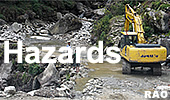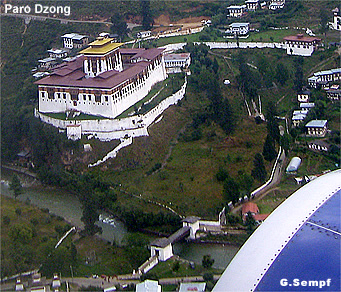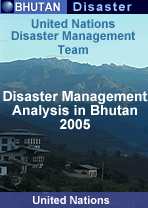| Natural hazards in Bhutan |
 |
Bhutan Earthquakes |
|
 |
Bhutan Earthquakes |
|
|
 |
|
Disaster Management Analysis in Bhutan
|
 |
Bhutan is prone to a number of natural hazards due to fragile geological conditions, steep sloping terrain, vulnerable ecosystem, great elevation differences, variable climatic conditions and active tectonic processes taking place in the Himalayas.
The following table shows the different types of natural hazards in Bhutan:
 Earthquakes; Earthquakes;
 Floods, including flash floods and glacial lakes outburst floods (GLOFs); Floods, including flash floods and glacial lakes outburst floods (GLOFs);
 Landslides; Landslides;
 Forest fires. Forest fires. |
 Outbreaks of pests and epidemic diseases; Outbreaks of pests and epidemic diseases;
 Droughts (local-level water stress); Droughts (local-level water stress);
 Wind, storms, hail, lightning. Wind, storms, hail, lightning. |
Earthquakes
Bhutan lies in one of the most seismically active zones of the world primarily attributable to the continent-continent collision of the Eurasian-Indian plates. Over a period of one year, a local temporarily seismic network established in collaboration with the University of Texas at El Paso has detected about 2,100 teleseismic, regional and local events, out of which 900 events (mostly M ≤ 4.0) are not listed in the global National Earthquake Information Centre catalogue.
 |
| Note that according to Bhutan's Country Report on Natural Disaster Reduction, another major earthquake is said to have occurred in 1931, which led to the collapse of the Utse of Jakar Dzong in Bumthang. In the same report, two earthquakes are mentioned for 1941 (January 21 and January 27), with respective magnitudes of 6.8 and 6.5 and their epicentres near the south-eastern border with India.Note also that in Bhutan UN Inter-Agency Humanitarian Contingency Plan (2004), mention is made of two other earthquakes: one in the year 1954 with a magnitude of 6.5 and located in Bhutan-China-India border region; the other one in the year 1960 with a magnitude of 6.5 and located near Tsirang; the latter is reported to have badly damage Pemayangtse Monastery. |
|
There is no information available for the period before 1897, except from an account by Shikya-rinchen (1710-1759) that makes mention of a major earthquake, which occurred in Western Bhutan in the spring of 1713 and resulted in the collapse of houses/huts and loss of life.
 |
| Source: United Nations Disaster Management Team, 2005 |
|
Information on Bhutan
|

|
|






